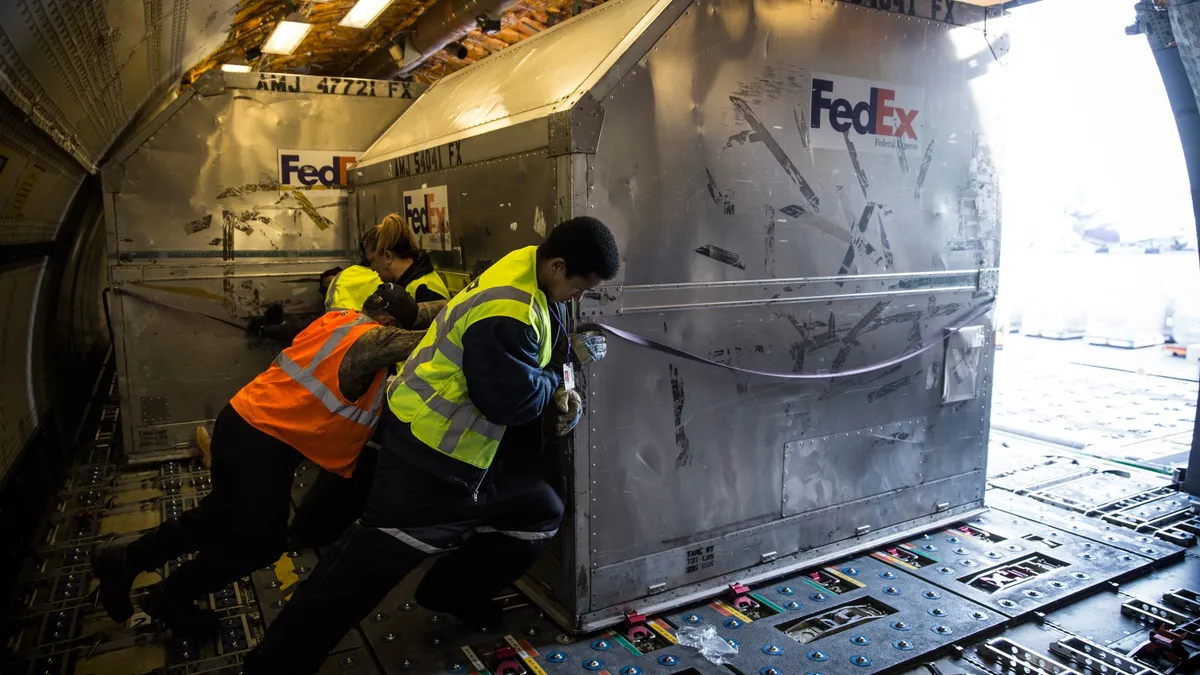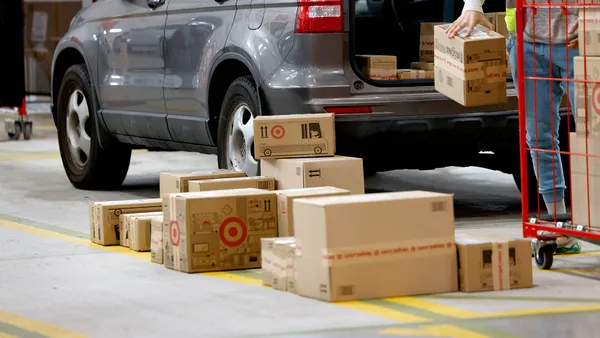Dive Brief:
- FedEx is rerouting more than 600,000 packages a day in its Ground network to keep up with service standards due to staffing shortages at company hubs, President and COO Raj Subramaniam said during the company's Q1 earnings call Tuesday.
- FedEx Ground's hub in Portland, Oregon, for example, has just 65% of the workers needed to handle normal volume, Subramaniam said. Around 25% of packages had to be diverted because they "simply cannot be processed efficiently to meet our service standards," he said.
- Diverting package volumes makes operations less efficient and more costly, Subramaniam said, as the company has to add additional linehaul and delivery routes and rely more on third-party transportation. CFO Mike Lenz said operational challenges due to labor shortages are expected to persist for the remainder of the calendar year.
Dive Insight:
FedEx's need for labor, which the company also flagged as an issue in the previous quarter, will only become more pressing as shippers bring it more volume for peak season.
Subramaniam said tackling staffing and retention challenges is the company's top priority as it's negatively affecting service levels and other aspects of its business. However, he said FedEx is assuming subsequent quarters are "going to be better than Q1" in terms of staffing.
"FedEx says they will struggle in Q2 (calendar Q4) but that it won't get worse," said Rick Watson, CEO and founder of RMW Commerce Consulting, in a LinkedIn post. "Logically this makes no sense since Q4 volume will increase."
FedEx wants to hire 90,000 new employees for the peak season to handle the inevitable surge in volume, and Subramaniam said the company is attempting to attract applicants with pay premiums, increased tuition reimbursement and other measures. Hourly rates for package handlers at FedEx Express' major sort locations and at FedEx Ground are up 25% and 16%, respectively, from a year ago, Lenz said.
But the labor market is currently a tight one, and FedEx is competing with other carriers and companies with a need for material handlers. UPS aims to hire more than 100,000 seasonal workers, and the Postal Service wants to bring on 40,000 holiday employees. DHL eCommerce Solutions, which aims to hire around 2,800 peak season employees to sort parcels, has introduced sign-on bonuses and incentives for those who refer family or friends to a position, said its Americas CEO Lee Spratt.
"We're paying peak-type wages today and will continue to pay those wages, and I'm not sure that the wage that we're currently paying will ever go back to where it was pre-COVID-19," Spratt said.
While labor remains a challenge, Subramaniam said FedEx Ground is expected to have "substantially higher" capacity to process parcels this peak season by bolstering its physical network. FedEx spent $85 million in Ground network investments in Q1 to bring online 16 automated facilities and expand 100 others, Lenz said. One new facility is a hub in Chino, California, that is "strategically located to help address ongoing port congestion challenges," Subramaniam said.
"This brings the total capacity increase of more than 1 million average daily volume compared to last peak," Subramaniam said.
Chief Marketing and Communications Officer Brie Carere said the current capacity crunch "has led to a very favorable pricing environment" for the company as it focuses on higher-yielding volumes. This includes B2B deliveries and shipments for small- and medium-sized businesses.
FedEx customers will soon face elevated shipping costs, with peak season surcharges and a higher-than-normal general rate increase taking effect in the coming months. Shipping rates for various Express, Ground and Freight services will increase by an average of 5.9% on Jan. 3, versus a 4.9% average on the previous rate increase.
According to a post on shipping intelligence platform Reveel's website, this marks the highest average rate increase since 2013 for FedEx. The rate increase will help balance FedEx's network capacity with customer demand, Carere said.
Editor's note: This story was first published in our Logistics Weekly newsletter. Sign up here.














